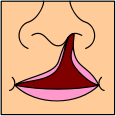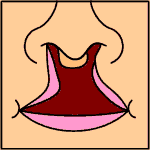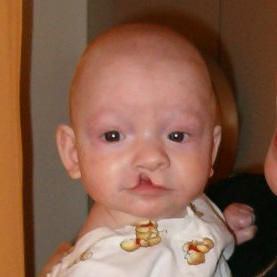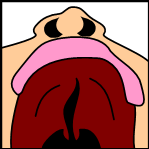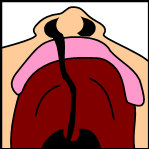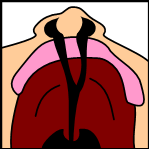Cleft lip and palate (patient information)
For the WikiDoc page for this topic, click here
Editor-In-Chief: C. Michael Gibson, M.S., M.D. [1]; Associate Editor(s)-In-Chief: Jinhui Wu, M.D.; Assistant Editor-In-Chief: Meagan E. Doherty;
Overview
Cleft lip and palate are birth defects that affect the upper lip and the roof of the mouth.
Cleft lip
If only skin tissue is affected one speaks of cleft lip. Cleft lip is formed in the top of the lip as either a small gap or an indentation in the lip (partial or incomplete cleft) or continues into the nose (complete cleft). Lip cleft can occur as one sided (unilateral) or two sided (bilateral). It is due to the failure of fusion of the maxillary and medial nasal processes (formation of the primary palate).
-
Unilateral incomplete
-
Unilateral complete
-
Bilateral complete
A mild form of a cleft lip is a microform cleft. A microform cleft can appear as small as a little dent in the red part of the lip or look like a scar from the lip up to the nostril. In some cases muscle tissue in the lip underneath the scar is affected and might require reconstructive surgery. It is advised to have newborn infants with a microform cleft checked with a craniofacial team as soon as possible to determine the severeness of the cleft.
-
3 months old boy before going into surgery to have his unilateral incomplete cleft lip repaired.
-
The same boy, 1 month after the surgery.
-
Again the same boy, age 1.5 years old. Note how the scar gets less visible with age.
Cleft palate
Cleft palate is a condition in which the two plates of the skull that form the hard palate (roof of the mouth) are not completely joined. The soft palate is in these cases cleft as well. In most cases, cleft lip is also present. Cleft palate occurs in about one in 700 live births worldwide.[1]
Palate cleft can occur as complete (soft and hard palate, possibly including a gap in the jaw) or incomplete (a 'hole' in the roof of the mouth, usually as a cleft soft palate). When cleft palate occurs, the uvula is usually split.It occurs due to the failure of fusion of the lateral palatine processes, the nasal septum, and/or the median palatine processes (formation of the secondary palate).
The hole in the roof of the mouth caused by a cleft connects the mouth directly to the nasal cavity.
Note: the next images show the roof of the mouth. The top shows the nose, the lips are colored pink. For clarity the images depict a toothless infant.
-
Incomplete cleft palate
-
Unilateral complete lip and palate
-
Bilateral complete lip and palate
What are the symptoms of Cleft lip and palate?
A child may have one or more of these conditions at birth.
A cleft lip may be just a small notch in the lip. It may also be a complete split in the lip that goes all the way to the base of the nose.
A cleft palate can be on one or both sides of the roof of the mouth. It may go the full length of the palate.
Other symptoms include:
- Misaligned teeth
- Change in nose shape (amount of distortion varies)
Problems that may be present because of a cleft lip or palate are:
- Failure to gain weight
- Feeding problems
- Flow of milk through nasal passages during feeding
- Misaligned teeth
- Poor growth
- Recurrent ear infections
- Speech difficulties
What are the causes of Cleft lip and palate?
There are many causes for of cleft lip and palate. Problems with genes passed down from one or both parents, drugs, viruses, or other toxins can all cause such birth defects. Cleft lip and palate may occur along with other syndromes or birth defects.
A cleft lip and palate can affect the appearance of one's face, and may lead to problems with feeding and speech, as well as ear infections. Problems may range from a small notch in the lip to a complete groove that runs into the roof of the mouth and nose. These features may occur separately or together.
Who is at risk for Cleft lip and palate?
Risk factors include:
- a family history of cleft lip or palate
- other birth defect
About 1 out of 2,500 people have a cleft palate.
How to know you have Cleft lip and palate (Diagnosis)?
A physical examination of the mouth, nose, and palate confirms a cleft lip or cleft palate. Medical tests may be done to rule out other possible health conditions.
When to seek urgent medical care
Cleft lip and palate is usually diagnosed at birth. Follow the health care provider's recommendations for follow-up visits. Call if problems develop between visits.
Treatment options
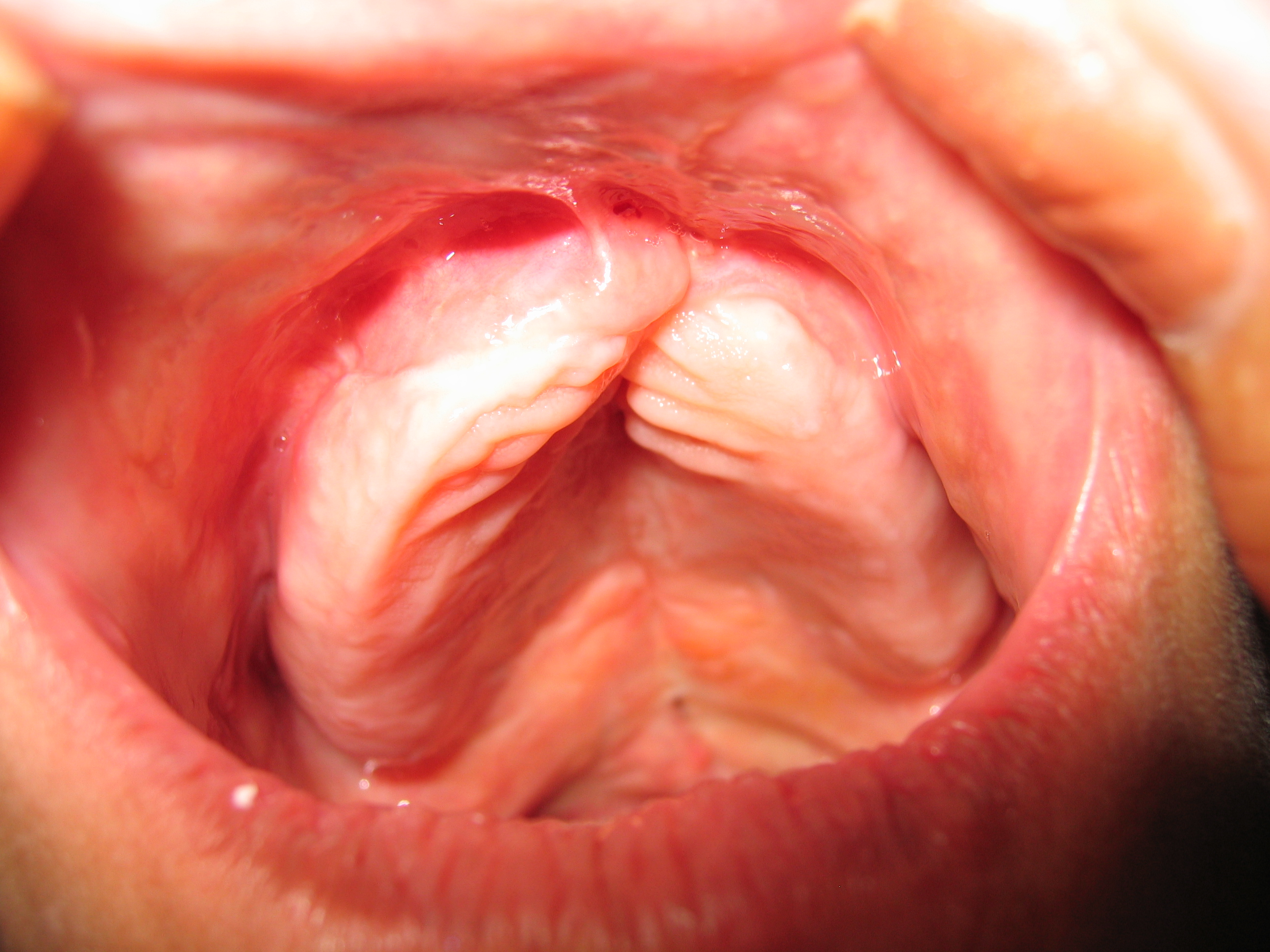
Surgery to close the cleft lip is often done at when the child is between 6 weeks and 9 months old. Surgery may be needed later in life the problem severely affects the nose area. See: Cleft lip and palate repair
A cleft palate is usually closed within the first year of life so that the child's speech normally develops. Sometimes a prosthetic device is temporarily used to close the palate so the baby can feed and grow until surgery can be done.
Continued follow-up may be needed with speech therapists and orthodontists.
Sample treatment schedule
Note that each individual patient's schedule is treated on a case-by-case basis and can vary per hospital. The table below shows a common sample treatment schedule. The colored squares indicate the average timeframe in which the indicated procedure occurs. In some cases this is usually one procedure (for example lip repair) in other cases this it is an ongoing therapy (for example speech therapy).
age |
||||||||||||||||||||||
| Palatal obturator | ||||||||||||||||||||||
| Repair cleft lip | ||||||||||||||||||||||
| Repair soft palate | ||||||||||||||||||||||
| Repair hard palate | ||||||||||||||||||||||
| Tympanostomy tube | ||||||||||||||||||||||
| Speech therapy/Pharyngeal surgery | ||||||||||||||||||||||
| Bone grafting jaw | ||||||||||||||||||||||
| Orthodontics | ||||||||||||||||||||||
| Further cosmetic corrections |
Diseases with similar symptoms
Where to find medical care for Cleft lip and palate
Directions to Hospitals Treating Cleft lip and palate
Prevention of Cleft lip and palate
While many cases of cleft lip and cleft palate are unpredictable, you can take steps to understand or lower your risk:
- Genetic counseling: A genetic testing can tell you how much a history of clefting in both your families increases your risk, as well as how blood or DNA samples can test for chromosomal syndromes.
- Taking prenatal vitamins: Some researches demonstrate that lack of folic acid or certain other vitamins may be related to some cases of cleft lip and cleft palate. Taking a prenatal multivitamin may decrease the risk of having a cleft lip and palate baby.
What to expect (Outlook/Prognosis)
Although treatment may continue for several years and require several surgeries, most children with a cleft lip and palate can achieve normal appearance, speech, and eating. However, some people may have continued speech problems.
Possible Complications
- Displaced teeth
- Hearing loss
- Lip deformities
- Nasal deformities
- Recurrent ear infections
- Speech difficulties
Sources
References
- ↑ "Statistics by country for cleft palate". WrongDiagnosis.com. Retrieved 2007-04-24.
